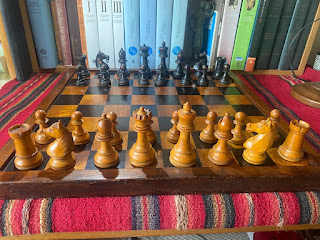The World'd Largest Chess Stamp Collection and other Philatelic Gems: A Conversation with GM Jon Edwards
Introduction:
In the enthralling realm where chess and philately converge, the fascinating pursuit of collecting chess-themed stamps stands as a testament to the enduring allure of both passions. Recently, in the August edition of the Chess Collector Hangout, I had the pleasure of speaking with Chess Grand Master Jon Edwards, a distinguished chess player (particularly, he is the 2023 World Correspondence Chess Champion) and an ardent collector. I was astonished to learn about his extraordinary passion for philately and chess-related memorabilia. Jon's dedication to his collection is truly remarkable, as he possesses an impressive assemblage of over 250 binders filled with an array of captivating chess stamps and other mail-related artifacts. While discussing his collection, Jon graciously shared insights into one of his prized compilations, aptly titled "Our 60 Memorable Gems." It became evident that Jon's expansive collection represents not only a remarkable assemblage of historical and artistic pieces but also a testament to his deep appreciation for the intersection of chess and philately. I thoroughly enjoyed our conversation and leaned a great deal about both chess history and the world of stamp collecting. Read to the end as there is a special chess match (PGN format) related to one of the historic pieces of mail Jon discussed. All images presented below are screenshots from Jon Edwards' presentation during the interview-enjoy!
Chess, History and Stamps- A Perfect Marriage:
The story of Jon's journey into the realm of chess stamps began in his high school days when he initially delved into the world of stamp collecting. During the podcast, Jon shared that his interest focused on stamps related to chess, which were offered for sale by collectors.
As an accomplished player who was appointed Grand Master of the Year by the U.S. Chess Federation, Jon's insights into the game were not merely superficial. Jon also holds a Ph.D. in History from Princeton, signifying his appreciation for history (Ethiopian Economic History nonetheless!). His extensive knowledge of chess history, tournaments, and iconic players added depth and context to his stamp collection. This unique blend of passions enabled Jon to see chess stamps not just as collectible items but as pieces of chess history and art that embody the essence of the game.
At the heart of this intriguing conversation was Jon Edwards' monumental chess stamp collection, which he has meticulously organized over the years. This stunning collection includes a myriad of stamps featuring chess motifs, chess legends, and historic chess events from around the globe. Jon's collection not only serves as a testament to his dedication to the art of philately but also embodies his profound love for the game of chess.
Chess Stamps and Art:
Jon's also had a deep appreciation for the artistic aspect of stamp design, as he discussed various drafts made by artists in the creation of new chess stamps.
Chess Stamps as a Reflection of History:
The conversation with Jon Edwards underscored the fact that chess stamps are not merely pieces of paper with artistic designs. They serve as windows into history, capturing moments, personalities, and events that have shaped the chess world. Whether it's an imperfection/error in the printing process, a commemorative cover, or an autographed stamp, each piece in Jon's collection carries a unique narrative that reflects the fusion of chess and culture.
My favorite printing error in Jon's collection was the misprint of a 1951 JOSE CAPABLANCA stamp which reads JOSF. Yes, I have to come to realize stamp collecting is not only cool but humorous!
Stamp Design and Production:
Jon also shared stories of stamps that featured intricate chess-themed artwork, often created by talented designers. Some stamps went through multiple stages of design and printing, resulting in beautiful sets and proofs that showcased the creative process behind each stamp.
Jon's dedication to his collection was evident in his pursuit of rare and limited-edition stamps. He recounted stories of tracking down elusive stamps and covers, often engaging in negotiations and overcoming challenges to add these treasures to his collection. The thrill of discovery and the satisfaction of finally acquiring a prized item were evident in his animated storytelling.
The International Correspondence Chess Phenomenon
Jon's collection extended beyond just stamps, encompassing a wide range of correspondence chess memorabilia. He explained that correspondence chess was once a popular and intriguing way for players to compete remotely, often involving the exchange of moves and analysis via postcards and letters. It was a precursor to the digital chess platforms we have today.
Jon's collection included a fascinating array of postcards, envelopes, and letters exchanged between players during their correspondence chess matches. These pieces were not just about the moves; they also contained snippets of chess analysis, friendly banter, and historical insights into the chess world of yesteryears. What caught my eye was a post-war correspondence match between USSR and USA, of which the envelope looks like it went through hell, and contains the signatures of both teams. It was like unearthing hidden treasure from a bygone era.
The 1890 Telegraph Match Between Steinitz and Chigorin:
One of the most heartening aspects of Jon's collection was his commitment to preserving chess history.
Jon shared the historic letter detailing the 1890 telegraph chess match between Wilhelm Steinitz and Mikhail Chigorin. The match was initiated in New York, most likely at the Manhattan Chess Club.
In this correspondence match, Chigorin challenged Steinitz to a game played via telegraph, with specific rules and a monetary stake. While Steinitz chose not to use a helper, Chigorin collaborated with a mathematician named Andre Markov. The transcript reveals the communication between Chigorin and Markov as they discussed the moves and strategies for the match.
According to Jon, this match holds historical importance, with its moves and analysis having been widely studied by chess enthusiasts. Steinitz had asserted in his book and put to the test in this match the validity of Nh6 (Game 1) and Nh3 (Game 2) in the Two Knights Defense (see below). Jon's discussion and analysis of this historic document showcase the significance of this telegraph chess match and its role in the exploration of chess strategies and theories.
Below are the two games played in this telegraph match:
Game 1: Chigorin - Steinitz 1890
Game 2: Steinitz - Chigorin 1890
Conclusion:
As my conversation with Grand Master Jon Edwards drew to a close, it became evident that chess stamps, postcards and other Philatelic items are more than just collectibles—they are portals to a rich and storied past. The intricate designs, historical significance, and the convergence of two diverse passions are what make chess stamps a unique and remarkable pursuit.












Comments
Post a Comment